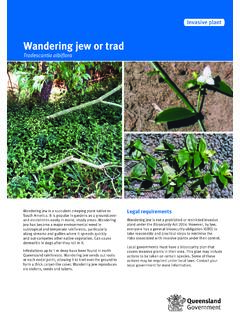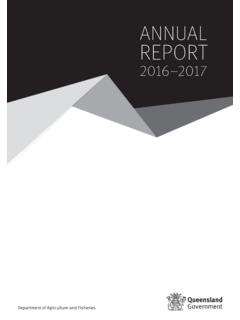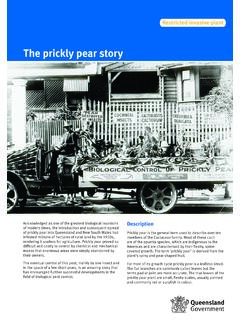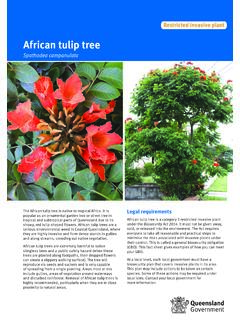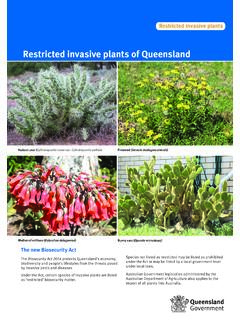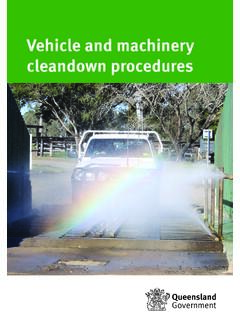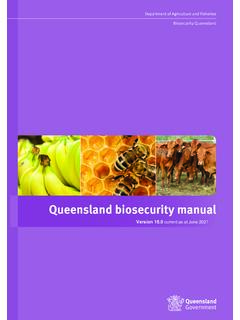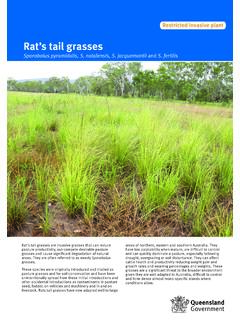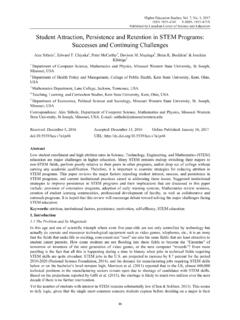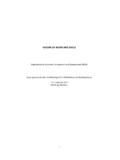Transcription of Parthenium
1 Parthenium is a vigorous species that colonises weak pastures with sparse ground cover. It will readily colonise disturbed, bare areas along roadsides and heavily stocked areas around yards and watering points. Parthenium can also colonise brigalow, gidgee and softwood scrub soils. Its presence reduces the reliability of improved pasture establishment and reduces pasture production potential. Parthenium is also a health problem as contact with the plant or the pollen can cause serious allergic reactions such as dermatitis and hay fever. Parthenium is recognised as a Weed of National requirementsParthenium is a category 3 restricted invasive plant under the Biosecurity Act 2014. It must not be given away, sold, or released into the environment.
2 The Act requires everyone to take all reasonable and practical steps to minimise the risks associated with invasive plants under their control. This is called a general biosecurity obligation (GBO). This fact sheet gives examples of how you can meet your hysterophorusRestricted invasive plant2 Parthenium Parthenium hysterophorusAt a local level, each local government must have a biosecurity plan that covers invasive plants in its area. This plan may include actions to be taken on certain species. Some of these actions may be required under local laws. Contact your local government for more Parthenium is an annual herb with a deep tap root and an erect stem that becomes woody with age. As it matures, the plant develops many branches in its top half and may eventually reach a height of 2 m.
3 Its leaves are pale green, deeply lobed and covered with fine soft hairs. Small creamy white flowers occur on the tips of the numerous stems. Each flower contains four to five black seeds that are wedge-shaped, two millimetres long with two thin, white cycleParthenium normally germinates in spring and early summer, produces flowers and seed throughout its life and dies around late autumn. However, with suitable conditions (rain, available moisture, mild temperatures), Parthenium can grow and produce flowers at any time of the year. In summer, plants can flower and set seed within four weeks of germination, particularly if of spreadParthenium seeds can spread via water, vehicles, machinery, stock, feral and native animals and in feed and seed.
4 Drought conditions aid the spread of seed with increased movements of stock fodder and and distributionParthenium is capable of growing in most soil types but becomes most dominant in alkaline, clay loam plant is well established in Central Queensland and present in isolated infestations west to Longreach and in northern and southern have also been found in northern and central parts of New South Wales and it is capable of growing in most states of partheniumThe GBO requires a person to take reasonable and practical steps to minimise the risks posed by Parthenium . This fact sheet provides information and some options for controlling and weed seed spreadPastures maintained in good condition, with high levels of grass crown cover, will limit Parthenium colonisation.
5 Drought, and the subsequent reduced pasture cover, creates the ideal window of opportunity for Parthenium colonisation when good conditions and implements passing through Parthenium infested areas should be washed down with water. Particular care should be taken with earthmoving machinery and harvesting equipment. The wash down procedure should be confined to one area, so that plants that establish from dislodged seed can be destroyed before they set caution should be taken when moving cattle from infested to clean areas. Avoid movement during wet periods as cattle readily transport seed in muddy soil. On arrival, cattle should be held in yards or small paddocks until seed has dropped from their coats and tails prior to their release into large paddocks.
6 Infestations around yards can be easily spotted and controlled whereas infestations can develop unnoticed in large care should be taken when purchasing seed, hay and other fodder materials. Always keep a close watch for the emergence of Parthenium or other weeds on areas where hay has been fed hygiene is important. Owners of clean properties should ensure that visitors from infested areas do not drive through their properties. If your property has Parthenium on it, ensure that it is not spread beyond the boundary or further within the control Hand pulling of small areas is not recommended. There is a health hazard from allergic reactions and a danger that mature seeds will drop off and increase the area of managementGrazing management is the most useful method of controlling large-scale Parthenium infestations.
7 Maintain pastures in good condition with high levels of ground and grass crown cover. This may require rehabilitation of poor pastures, followed by a sound grazing maintenance pasture establishment Poor establishment of sown pastures can allow Parthenium colonisation. Pasture agronomy Aerial seeding prior to scrub pulling is normally High grazing pressure caused by drought or high stock numbers decreases the vigour and competitiveness of pastures and allows the entry and spread of Parthenium . Maintenance of correct stock numbers is most important in controlling spelling In situations of serious infestation, pasture spelling is essential for rehabilitation. Total spelling is much more effective than simply reducing the stocking rate. However, overgrazing of the remainder of the property must be most appropriate time for pasture spelling is the spring summer growing period, with the first 6 8 weeks being particularly important.
8 If the condition of perennial grasses (native or sown) is low, spelling for the entire growing season may be required or introduced grasses may need to be re-sown. Herbicide treatment can hasten the rehabilitation process by removing a generation of Parthenium seedlings and allowing grass seedlings to establish without competition. In the presence of Parthenium , grass establishment is Parthenium hysterophorus 3 Grazing during winter should not increase the Parthenium risk. Most tropical grasses are dormant and can tolerate moderate grazing during this period. However, Parthenium may germinate and grow at this One of the main problems in controlling Parthenium is the large paddock size and the variability of country within paddocks. The resulting uneven grazing pressures encourage Parthenium to colonise the heavily grazed country.
9 Ideally, similar land types should be fenced as single units. Fencing can be used to great effect to break up large paddocks, allowing more flexible management such as pasture spelling or herbicide application, options not available Burning is not promoted as a control strategy for Parthenium . However, research suggests that burning for pasture management ( woody weed control) should not result in an increased infestation if the pasture is allowed to recover prior to the resumption of grazing. Stocking of recently burnt areas known or suspected to contain Parthenium decreases pasture competition and favours Parthenium , ultimately creating a more serious infestation. Biological control The combined effects of biological control agents reduced the density and vigour of Parthenium and increased grass production.
10 There are currently a number of insect species and two rust pathogens that have been introduced to control Parthenium a selection of these are outlined below. Epiblema strenuana is a moth introduced from Mexico established in all Parthenium areas. The moth s larvae feed inside the stem , forming galls that stunt the plant s growth, reduce competitiveness and seed production. Listronotus setosipennis is a stem -boring weevil from Argentina but is of limited success in reducing Parthenium infestations. Zygogramma bicolorata is a defoliating beetle from Mexico which is highly effective where present. It emerges in late spring and is active until autumn. Smicronyx lutulentus (Mexico) lays eggs in the flower buds where the larvae feed on the seed heads.
